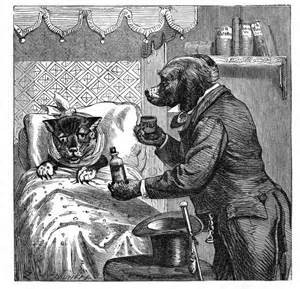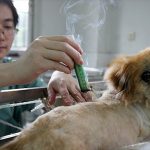The “Healing Crisis”
Once a pet owner has made the decision to change their dog or cat’s food to a more natural species appropriate diet of raw meaty bones and organs, and then stop the use of vaccinations, drugs, chemical flea-tick powders on their pets, the owner may observe in their animal a condition called a “healing crisis.” As scary as that sounds it’s actually a natural process of detoxing. All the morbid matter, or toxins, that have accumulated in the body for months, or years at a time, now begin to eliminate and this can manifest in symptoms that appear identical to an illness. The “symptoms” may appear as: lethargy, vomiting, fever, diarrhea, hot spots, itchy skin, dull or thinning coat, hair loss, smelly or itchy ears, and mucus and/or blood in the stools.
Don’t panic!
And, don’t run off to the nearest allopathic veterinarian who’ll probably prescribe pills to suppress the “symptoms.” Administering drugs defeats the purpose of a detox. Because as the body struggles to rebuild the immune system by throwing off toxins through the skin and orifices, using drugs is like adding more wood to the fire and will further weaken the already impaired immune system and that can lead to a chronic and incurable degenerative disease.
When these symptoms arise it’s imperative to remain patient and know that the body is ridding itself of toxins. The detoxing symptoms are only temporary and once over the hurdle the animal will now have a stronger and more efficient immune and elimination system.
There are several factors that will determine how long the “healing crisis” will occur, such as, the age of the animal, how long the dog/cat has been on an inappropriate diet of commercial food, how many vaccinations the animal has received over its lifetime, what medications the animal was on, and the genetics of the dog, or cat. But, animal naturopaths have observed that the average length of a “healing crisis”—followed by the evident increase in health—is one month for every year of life.
However, your pet may not go through a healing crisis. For example, when my Siamese cat, Poppy, was 8 years old I made the choice to change her food to a species appropriate diet and the transition was easy & immediate, and she experienced no “healing crisis” (I think one of the reasons my cat didn’t experience a “healing crisis” is because I’ve never vaccinated her). But, if this is not the case for your pet then there are things one can do to make the detoxing period easier. First: slow down the transition to raw food. You can do this by mixing raw meat with the canned food, and gradually over a period of days or weeks, decrease the canned food and increase the raw until the dog, or cat, takes to only raw meat. Or, you may fast your dog for 24 or 36 hours before attempting a raw meal. Fasting your dog is safe and natural. Your dog’s wild cousin, the wolf, never eats every day. The wolf will gorge itself on food and then will go without for several days (or, weeks) before eating again. Partly, because prey may be scarce and partly because the wolf isn’t hungry. It’s the way Mother Nature has designed the animal and your dog is a “little wolf.” Plus, and more importantly, fasting allows the dog’s digestive system to rest and encourage deeper healing. But if you’re concerned about the dog during a fast then you may add a tablespoon of raw, local or Manuka honey in his purified water.
However, I hestitate to fast a cat, especially if it is overweight. They have a more sensitive liver than a dog, and depriving a cat of food may cause a condition called hepatic lipidosis, a degenerative liver condition where the liver becomes congested from a buildup of fat. So, instead of putting a cat on a fast it would be better to do the gradual change over to raw food. Also, do not fast a puppy under the age of one year.
When starting the transition to a natural diet it’s not unusual to see some vomiting or diarrhea. This is the body’s way of expelling toxins, and it is especially true if your dog or cat has been on a diet of commercial canned pet food and kibbles for a long time. I should also mention that when you change the diet, you also change the microbiome. So, remember the diarrhea/vomiting is only temporary, because it may take a little time for the “good bacteria” or enzymes to build up in the digestive tract. And that’s because years of a poor diet of ultra-processed food has caused a depletion of vital enzymes. In this case, supplements of earth-based probiotics, or raw green tripe, can help replenish the good bacteria in the animals’ guts, and this should help ease the vomiting and diarrhea.
Although I urge to wait out the “healing crisis,” there are exceptions. If the dog or cat “goes off its food” for more than 36 hours, and/or maintains a high temperature for more than a day or two, then immediately seek the advice of a holistic veterinarian who understands the “healing crisis,” and may be able to help with a natural remedy for these symptoms.
The Hering’s Law of Cure
In Homeopathy, Dr. Constantine Hering, wrote about his observations of healing which later became known as Hering’s Law of Cure:
1. When cure is underway, symptoms move from inside to outside.
2. They also move from head to toe, quite often (or tail, in our animals).
3. And finally, they often move back through history. So the most immediate problems clear first, followed by older and older ones, until the patient is well.
Once the animal has past the “healing crisis” you now will have a healthier pet with a stronger immune system, clearer eyes, calmer disposition, more energy, and who now will thrive, rather than just survive.










